
views
- Spread a step-in harness out on the floor, and gently place your dog’s paws into the loops. Then pull the harness upward to your dog’s chest and clip it behind their back.
- Slip the smaller hole of an overhead harness over your dog’s head. Place their foot in the closed loop, and bring the loose buckle up behind the other leg. Clip it in place.
- Attach your leash to the back D-ring of the harness if you’re walking a calm or small dog. Use the front D-ring to better control an aggressive or overactive dog.
Putting on a Step-In Harness

Place the unbuckled harness on the ground. Find a roomy, flat surface, and lay the step-in harness flat on the ground. Note that the harness has 2 leg loops separated with a strap down the middle and parts of a buckle on either side. Spread out the loops so that it’ll be easier to for your dog to step into the harness. Vest harnesses and padded chest harnesses are types of step-in harnesses. They may look slightly different, but the general idea is the same. If your harness has a vest or chest cover attached to it, make sure the outside is facing down toward the floor.
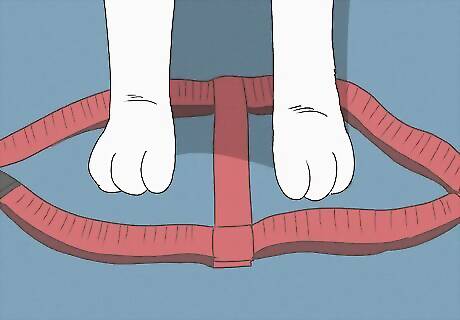
Place your dog's front paws into the loops on the harness. Call your dog over and have them “sit” and “stay” before the harness. Pick up the dog’s right paw and gently move it forward into the right loop. Then do the same with the left paw. If your dog doesn’t know “sit” and “stay,” entice them toward and into the harness with treats or have a partner hold or calm them while you work. Some harnesses label which side is meant for which paw. However, many harnesses are reversible. Check your harness to see which type you have. With mesh or double-strapped harnesses, the smaller “hole” or shorter straps typically go around the neck, and the longer around the chest.
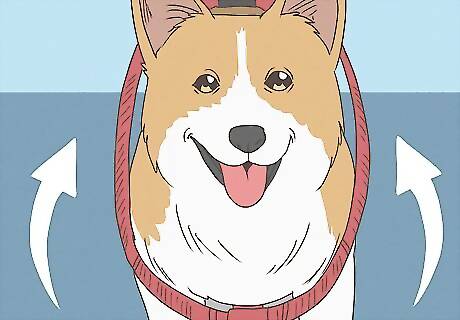
Pull the harness up around your dog and secure it with the clips. Pull the harness upward so that it evenly contacts your dog’s chest, and not just their neck. The loops will settle at the top of the dog’s legs and against their belly. Tug the side straps up over the dog’s shoulders and onto their back, and snap the clip or clips into place to secure it. For a double-strapped harness, start by securing the neck clips, then work on the back or belly clips.
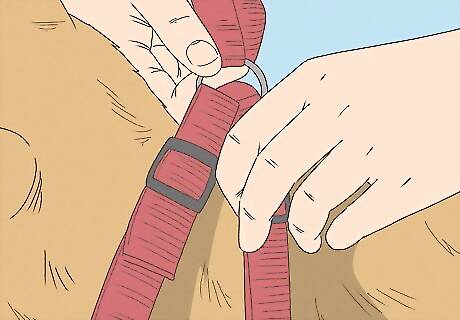
Adjust the harness to snugly fit your dog. Feed the adjustable straps on the harness through their plastic pieces to tighten or loosen the straps. Make sure the straps aren't loose enough to come off the dog, but not so tight that it causes chafing or restricts your dog’s movement. If you can fit 2 fingers under the straps, the harness is well-fitted. Briefly walk your dog around your home to check that the dog can’t easily slip out of the harness. Make sure it won’t easily come down over the dog’s paw or up over their head. You may need to adjust the harness every time your dog wears it to ensure a good fit.
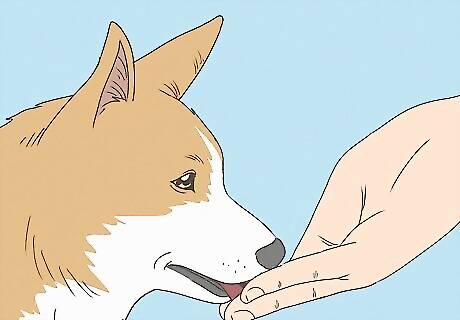
Reward your pup with a treat and praise. This teaches your dog to enjoy putting on their harness. It also makes it easier for you to put on the harness in the future, as your pup will look forward to the treats!
Securing an Overhead Harness
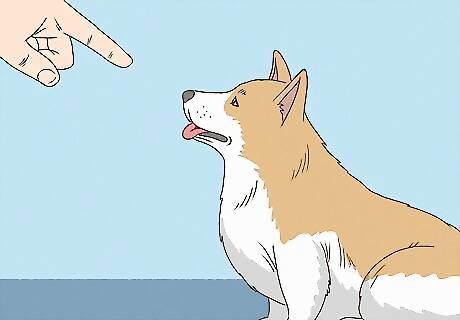
Command your dog to “sit” and “stay.” It’s easier to put the overhead harness on the dog if they sits still. If you haven’t trained your dog to “sit” or “stay,” call them over and gently hold them by the collar, speaking to them in a calm and encouraging tone to relax them.
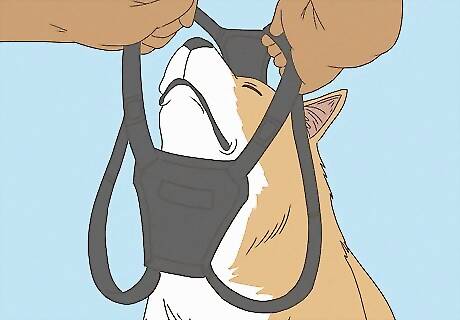
Slip the neck loop over your dog’s head. On an overhead harness, the neck loop is often a closed circle without buckles, with 2 straps leading down to a larger loop with a buckle. Slide the smaller loop over the dog's head and position it low on the dog's shoulder area so it isn't high around the neck. If your harness has chest pads, these go on the underside of the harness. Overhead harnesses might also be referred to as “standard” harnesses. If you’re using a special no-pull harness, the head loop is most likely the larger loop. The leash buckle is positioned in front of the dog’s chest.
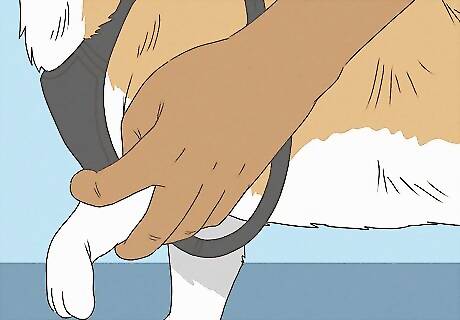
Put one of the dog’s paws into the loop on the harness. Overhead harnesses often have a closed leg loop on 1 side, with an open loop and a buckle system on the other. Lift the dog’s paw up off the floor and slide it into the closed loop. Then, put your dog’s paw down on the floor. These loops may be either on the left or right of the harness, depending on the product, so consult your owner’s manual if you need clarification.
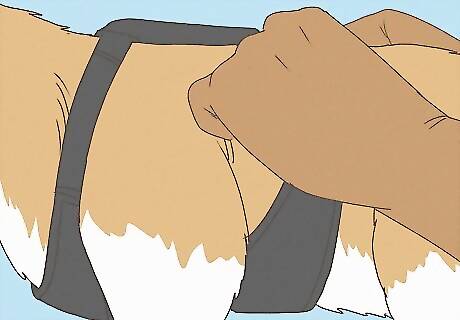
Loop the remaining strap under your dog’s belly and up toward their back. This effectively turns the strap into a leg loop. Make sure the strap goes under and behind the dog’s leg, which is important for controlling and securing the dog while walking. Then, clip the strap into the other half of the clip, most often located on the back of the harness. Ensure the clip is properly fastened, listening for the distinct “click.” Once the harness is on your dog, they will look like both legs are inserted into side loops.
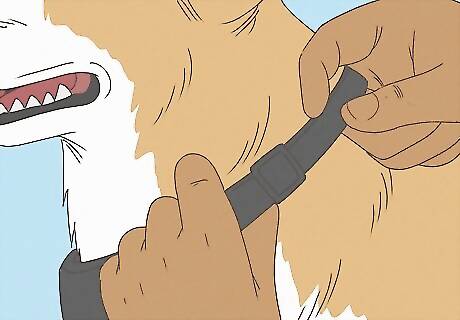
Adjust the harness’ fit using the plastic adjusters. Slide the adjusters to tighten or loosen straps, as necessary. Make the harness snug, but not so tight that it chafes or digs into your dog’s skin. Pull on the straps to check that the neck hole and leg loops aren't loose enough for your dog to get out of them. Then, check that you can fit 2 fingers under the straps to ensure it's not too snug. Adjust the harness every time you use it to ensure your dog is secure and comfortable. Check that the harness feels secure against your dog's fur but not pressed tight against their body.
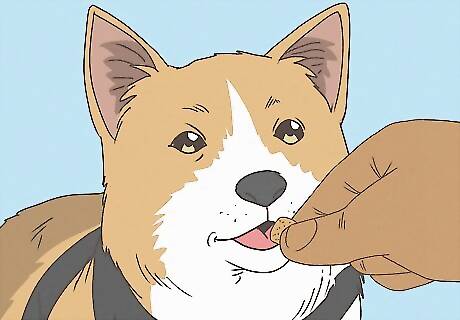
Give your pup a treat and lots of praise to reward them. Ideally, your dog will think of putting on their harness as a pleasant, exciting activity. Giving them a treat or 2 every time you fit their harness teaches them to think of the harness positively, making it easier to outfit the dog for future walks.
Attaching a Leash
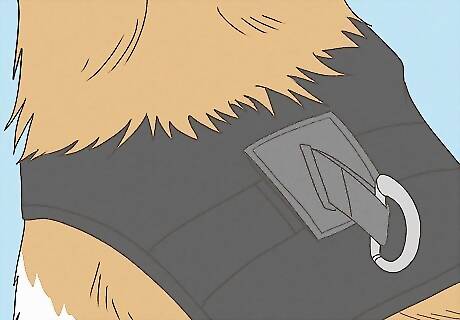
Locate the D-shaped leash clip. Basic harnesses have a leash clip in the back, while training or no-pull harnesses usually have a clip in the front. The clip is typically shaped like the letter “D” and attached to the harness with a sturdy bit of fabric. Only attempt to attach the leash to these clips, since other areas of the harness may break under pressure.
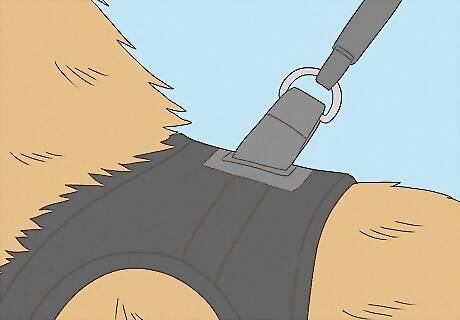
Clip the leash on the back of the harness for calm dogs and small dogs. Back-clip harnesses provide a comfortable walking experience for dogs that don’t pull or jump. These harnesses are also safe for little dogs that have small, sensitive necks. Clipping your leash to the back of the harness also reduces tangles while walking.
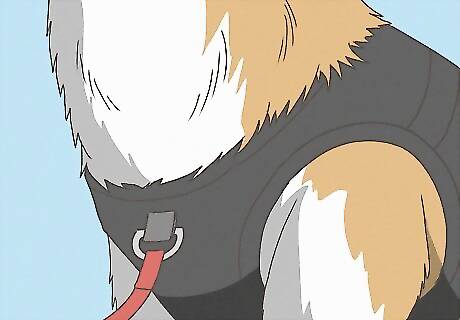
Attach the leash on the front to train or control your dog. Using a front-clip on a harness allows you to have more control over your dog, especially if they tend to pull or jump. If your dog tends to lunge, they’ll be spun back to face you. These clips are great for aggressive or overactive dogs. Front-clip leashes are more easily tied up in your dog’s legs. If this happens, stop and untangle the dog.



















Comments
0 comment